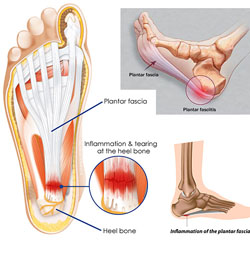
This article was published on: 10/22/21 11:39 AM
Plantar fasciopathy is a disorder that is caused in the connective tissue which helps in supporting the arch of the foot called the plantar fascia. It is the most common type of plantar fascia injury and is responsible for heel pain in most cases. Plantar Fasciopathy occurs more often in women, military recruits, older athletes, dancers, and young male athletes. It usually causes pain in the heel and bottom of the foot. You feel the pain while bending your foot and toes up towards the shin. The cause of Plantar Fasciopathy is not clear yet but some common factors include a sudden increase in exercise, standing for a longer period, obesity, excessive running, standing on hard surfaces for prolonged periods, etc. Plantar fasciitis is usually a result of some biomechanical imbalance that causes an increased amount of tension placed along the plantar fascia.
When Plantar Fasciopathy occurs you will experience a sharp pain in your heel and usually unilateral, numbness, tingling, and swelling. The pain is most intense during the first step after getting out of bed or after sitting for a long period. It might improve after continued walking. Typically there are no fevers or night sweats.
It is meant that Plantar Fasciopathy heals with time and by following some conservative methods prescribed by your doctor. Usually, for the first few weeks, you are advised to rest and take some painkillers. If you are not sufficient you may opt for alternatives such as physiotherapy, orthotics, splinting, or steroid injections. You should complete the exercise advised by your physiotherapist to heel your pain and should continue to do your exercise even though your heel pain has gone. Don’t get back to your running activities until and unless your heel has been pain-free. . You might experience a slight pain while exercising but if the pain increases you should contact your doctor immediately. It is advisable to avoid performing activities that cause pain in your heel. Even after your treatment if you go back to your regular exercises, you should be careful and slowly progress.
If you didn’t get effective results, you may go for extracorporeal shockwave therapy or surgery. If plantar fasciitis doesn’t resolve after six months of conservative treatment, then the procedure that is opted for is surgery